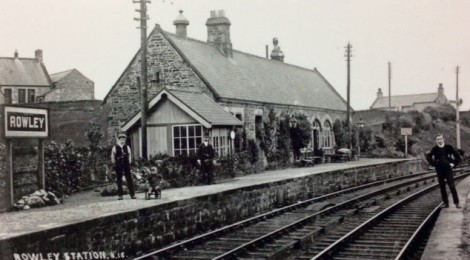
North Eastern Railway Station Gardens Team…
As part of a project funded by the Major Partner Museums scheme (MPM), the station gardens at Rowley are receiving dedicated attention from staff member Fiona Pembroke. The funding allows staff across the Museum to carry out projects or exercises right across site, and most of the 18 or so participants are working outside of their usual sphere or area of work with this programme. Fiona is looking at the recreation of the once prize-winning gardens for which Rowley became noted, and has prepared this article to show the first phase of development at the station. We will then feature the ongoing enhancement of this area on the blog.
NER Station Gardens by Fiona Pembroke
Redevelopment of station gardens
As part of the people development programme at Beamish a project was set up to bring the station gardens back to the award winning design of the early 1900’s.
The brief was also to include community groups from outside the museum in a project to provide a lasting visitor legacy.
The station was moved from Rowley which is about 8 miles west of Beamish. on the A68 road near Castleside. The station was opened at Rowley to goods and freight in 1845 and to passengers in 1846. (Photo above). It closed to passengers in 1936 and goods and freight in 1966. It became derelict and was later moved to Beamish where it was first opened as an exhibit in 1973.
The project began with the research, looking for photographs and other archive material depicting the station gardens in their prime and in the pre First World War era in which the area is now set. There are quite a few photographs within the Beamish museum archive where the structure and planting within the station gardens is visible. It also produced a copy of the North Eastern Railways ‘Best Kept Wayside station’ certificate from 1920. (Photo below). The station (and its staff) won this award in 1912. The award was then suspended for the duration of the 1st World War, resuming in 1920, when Rowley station again won the award, later still winning it again. This achievement appears to have been down to the new Station master, George Beattie who took up his post in November 1911.
The gardens and grounds around the station in the early years of the 20th century were well cared for. This was also the case prior to George Beattie’s appointment, when the Station Master was another George, this time George Bainton. Looking at the archive photographs you can see where flower beds had been dug out and the grounds generally appeared well maintained.
The initial stage of the project was to carry out research into the history of Rowley station itself and in particular the gardens. Once the photographs were available it was then possible to look at the design of the flower beds and also the planting and research period-appropriate plants that would replicate this.
Along side this a Men’s group was set up by the Well being team, to volunteer and work at the Station. The members of this group are all younger men in their 40’s or 50’s who are living with dementia. This group are now an invaluable part of the Station team and are currently working on repairing and painting the station fencing. It is hoped that when the Station Master’s allotment is in place that they will have a large role in planting and maintaining it. There are also some other community groups that may well have some shorter term involvement and a Business Friends Partner who are also interested in being involved with the station redevelopment.
The next phase of the project was to actually dig out the main flower bed on the bank that runs between the signal box and the Booking office building. This is the largest bed and measures approximately 34 metres in length. The archive photographs show a large central flower bed with shrubs and what appears to be some annual planting sound the edges. There is also planting cascading over the wall down towards the track and a border along the back of the bank with flowering shrubs. At present the new flower bed has been dug out by the gardening team and is about to be planted up.
The following phase of the project will be to replicate and plant up the beds and tubs along the platform. Once that is complete the plan is to dig out station Master’s allotment. So far no evidence has been found to show that the Station Master had an allotment at the station but research is continuing as allotments were a feature of other NER stations. At Rowley the Station Master’s house is very close to the Station and it is entirely possible that he had his own allotment as he was a keen gardener and allotment gardens were common place at that time. This allotment would allow us to tell the story of life at at small country station in the early 1900’s before the impact of the First World War. Beamish has on site a disused North Eastern Railway hut. The plan is refurbish this and then place this along side the Station Master’s allotment to be used to store the gardening tools and as a general purpose space. This will add some more depth to the station as an exhibit.
At present the Station at Beamish, as a whole, is being redeveloped so that we can better depict life at the station in the early years of the 20th century and widen the range of engagement opportunities for visitors to experience in this area.













Recent Comments